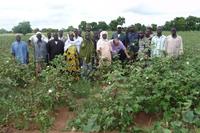PASE II - Mali
Last update: 5 April 2018
Duration: 2013-2016
The 12.5-million-euro PASE II project (an 11-million-euro grant from the AFD and 1.5 million euros from the EU) had five components. One, on improving the productivity and sustainability of family farms (1.1 million euros), was led by the CNRA (Centre National de la Recherche Agricole) and coordinated by the IERand CIRAD, did not begin until 2014. Its aims were to:
- facilitate steering and decision-making on a supply chain, territory and collectivity scale, by consolidating an information system on agrarian dynamics in the cotton growing zone,
- increase farm revenues sustainably by creating innovations in partnership and promoting approaches to support producers, hence contribute to their dissemination.
There were also two complementary lines of research:
- the information system on agrarian dynamics in the cotton growing zone,
- and the sustainable intensification of farming systems, which encompassed five activities.
One of those activities more particularly concerned the DIVECOSYS platform, since it involved drafting integrated cotton crop protection strategies. It was led by three researchers, Idrissa Téréta (IER), Mamoutou Togola (IER) and Alain Renou (CIRAD), who benefitted from support missions by CIRAD experts.
The aims were to reduce insecticide use on cotton crops, by promoting and improving two innovations: threshold treatments and hand topping of cotton plants.
The former cuts insecticide use by 70% (Renou et al., 2012) and the latter reduces bollworm population levels (Renou et al., 2011). Bollworms are the main cotton pests in Mali (Cabanilla et al., 2005).
This activity encompasses various operations:
- training courses for producers and supervisory staff,
- monitoring of phytosanitary practices,
- tests on producers' farms, using a research-action in partnership approach, going as far as the dissemination of innovations,
- and on-station adaptive research to determine the conditions for implementing the two phytosanitary innovations so as to ensure optimum effects, either in interaction with other innovations or not.
The operations were conducted in six villages (Benguéné, Ziguéna, Nafégué, Kokélé, Katabantankoto and Kafara) chosen as representative of the diversity of cotton growing zones in Mali, and on the Farako research station near Sikasso.
Bibliography:
Cabanilla, L.S., Abdoulaye, T., Sanders, J.H., 2005. Economic cost of non-adoption of Bt-cotton inWest Africa: with special reference to Mali. International Journal of Biotechnology 7, 46-61
Renou, A., Téréta, I., Togola, M. 2011. Manual topping decreases bollworm infestations in Mali. Crop Protection. 30, 1370-1375.
Renou, A., Téréta, I., Togola, M., Brévault, T. 2012. First steps towards « green » cotton in Mali. 2012. Outlooks on Pest Management. August 2012, 173-176.
Last update: 5 April 2018


